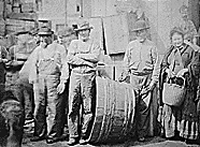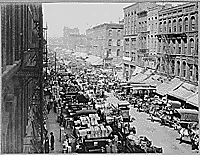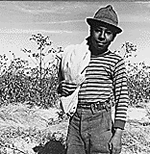Spotlight Archive
Congress and the nation currently debate immigration law reform, prompted primarily by high levels of immigration from the predominantly Catholic countries of Latin America. Hispanic Americans are but the latest in a series of migrant ethnic groups that have contributed to the makeup of the Catholic Church in the United States—a church that is, as the title of one recent survey of American Catholic history has it, a “Communion of Immigrants.”
Given its history as a colonial outpost, all non-Native American residents of North America were in some sense immigrants. The earliest significant group of Catholic immigrants to British North America in the colonial era was the party of Englishmen who arrived aboard the Ark and the Dove to settle Lord Cecil Calvert’s colony of Maryland. Other pre-Revolutionary Catholic colonists included some Germans, who found religious freedom in Philadelphia and the Pennsylvania countryside and were served by German priests such as Ferdinand Farmer. Most Irish colonials were Scots-Irish Presbyterians, but several thousand Cathlic Irish also came and settled throughout the colonies; many were indentured servants in the southern colonies, where there was no organized Catholic Church.
Other immigrants came from less distant homelands. French Catholic Canadians, who had initially settled in the Maritime Provinces (Acadia), were expelled by the British after 1755. Several thousand made their way south to Louisiana, where they formed a distinctive culture and became known as Cajuns.
After the Revolution, the unfolding of the American experiment gradually formed the United States into an irresistibly attractive destination for millions of nineteenth-century emigrants. The combination of economic prosperity and religious and political freedoms drew Europeans across the Atlantic and Asians across the Pacific. Factors such as war, religious persecution, and financial hardship in their native countries contributed to the supply of emigrants en route to America’s shores.
 Ethnic groups—the Irish and Germans—who had settled during the colonial period continued to dominate immigrant lists through the century. Though immigration of these ethnics was sustained throughout the century, there were several distinct waves of immigration that swelled the ranks of Catholics in the New World. The Irish potato famine of 1845–1855 gave impetus to a mass exodus from the Emerald Isle. More than 1.5 million Irish came to the United States in those years. The Church in Boston, New York, Philadelphia, and San Francisco expanded to accommodate the Irish believers.
Ethnic groups—the Irish and Germans—who had settled during the colonial period continued to dominate immigrant lists through the century. Though immigration of these ethnics was sustained throughout the century, there were several distinct waves of immigration that swelled the ranks of Catholics in the New World. The Irish potato famine of 1845–1855 gave impetus to a mass exodus from the Emerald Isle. More than 1.5 million Irish came to the United States in those years. The Church in Boston, New York, Philadelphia, and San Francisco expanded to accommodate the Irish believers.
Germans for their part came in huge numbers during the same period, and were the largest national group from 1860 to 1890. (In the 1880s alone, some 1.4 million arrived.) Jews, Catholics, and Protestants (Lutherans, Reformed, Anabaptists), were all well represented among the newcomers. Catholic Germans changed the religious landscape of cities such as St. Louis, Milwaukee, and Cincinnati, and of rural areas in Wisconsin, Illinois, Iowa, Ohio, Minnesota, the Dakotas, and Nebraska, and formed scattered communities in Kansas, Oklahoma, and Texas.
French Canadians, now from Quebec, also continued to enter the United States. Almost one million came between 1840 and 1930, many remaining in the nearby state of New Hampshire.
On the east coast, from 1855 to 1890, Castle Garden on the southern tip of Manhattan served as the immigration processing office. More extensive quarters were built on Ellis Island, which from 1892 to 1924 was the portal through which three-fourths of all immigrants in those years entered America. As the century turned, patterns of immigration shifted. Overwhelmingly Catholic, millions of Italians, Slovaks, Slovenians, Poles, Hungarians, Ruthenians, and Lithuanians sailed for America in the first two decades of the twentieth century. Italians formed large communities and dozens of new parishes in Boston, New York, Philadelphia, Baltimore, and San Francisco. Hungarian, Slovak, Croatian, and Slovene immigrants swelled the cities of Cleveland and Pittsburgh. Slovaks, Slovenes, and Ruthenians (from the Ukraine) spread across Pennsylvania, working the coal mines, anthracite fields, and steel mills that fired American industry. Catholic Basques settled in Boise and rural Idaho and California.
The midwestern town of Chicago exploded into a metropolis as Italians, Poles, Czechs, and Lithuanians poured in. Joining them in  the melting pot were migrants crossing the nation’s southern border, Mexicans pushed by political unrest at home and pulled by the promise of well-paying jobs to the north. Large numbers of Mexicans also settled in Los Angeles, San Antonio, Detroit, and throughout the southwest, where Spanish culture had roots that pre-dated the Revolution.
the melting pot were migrants crossing the nation’s southern border, Mexicans pushed by political unrest at home and pulled by the promise of well-paying jobs to the north. Large numbers of Mexicans also settled in Los Angeles, San Antonio, Detroit, and throughout the southwest, where Spanish culture had roots that pre-dated the Revolution.
Immigration did not come without challenge. The American Party (Know-Nothings) emerged in the 1850s as an anti-immigrant and anti-Catholic political vehicle. Chinese immigration was targeted in restrictions in the 1880s, and the American Protective Association was formed in 1887. The Ku Klux Klan revived in the 1920s amidst a nativist mood that swept restrictive immigration laws into effect and choked the inflow of southern and eastern Europeans.
With the return of prosperity and more permeable borders, immigration began to pick up again in the 1940s. Hispanic immigrants were now the largest segment of newcomers, though there were also some new groups who added to the cultural mix. Mexicans continued to filter into exiting Hispanic communities in Chicago and the southwest, but they also  spread in significant numbers to Colorado and the cities of the midwest and southeast. Puerto Ricans formed a large population in New York, as did emigrants from the Dominican Republic (500,000 in the metro area). Two hundred thousand Cubans fled the revolution of 1959, many settling in Miami. Filipinos moved to southern California, Hawaii, and New Jersey, Haitians to New York. Catholics from nations not predominantly Catholic also came in significant numbers: Vietnamese to Los Angeles, Houston, and New Orleans; Indians to the eastern seaboard; Iraqi Chaldeans and Lebanese to Detroit.
spread in significant numbers to Colorado and the cities of the midwest and southeast. Puerto Ricans formed a large population in New York, as did emigrants from the Dominican Republic (500,000 in the metro area). Two hundred thousand Cubans fled the revolution of 1959, many settling in Miami. Filipinos moved to southern California, Hawaii, and New Jersey, Haitians to New York. Catholics from nations not predominantly Catholic also came in significant numbers: Vietnamese to Los Angeles, Houston, and New Orleans; Indians to the eastern seaboard; Iraqi Chaldeans and Lebanese to Detroit.
As in the late decades of the nineteenth century, the final thirty years of the twentieth saw a historic peak in immigration levels. Aided by legal reform in 1965, Asian and Latin American immigration especially increased. By the year 2000, more than 30 million Americans were foreign-born, the largest number ever—though, at 12%, lower as a percentage of the total population than in the second half of the nineteenth century. As in the previous century, the twentieth century’s immigrants were majority Catholic. Unlike the previous influx of Europeans, the late twentieth century was dominated by Hispanic migrants.
Melting pot or salad bowl? Uprooted or transplanted? Historians debate the nature and significance of immigration and assimilation, Catholic and otherwise. But there is no disputing that immigrants have made America what it is, and that the Catholic people of the United States are, in large measure, the contemporary face of a history of migration.
Sources and Further Reading (See the full bibliography on Catholics and immigration)
